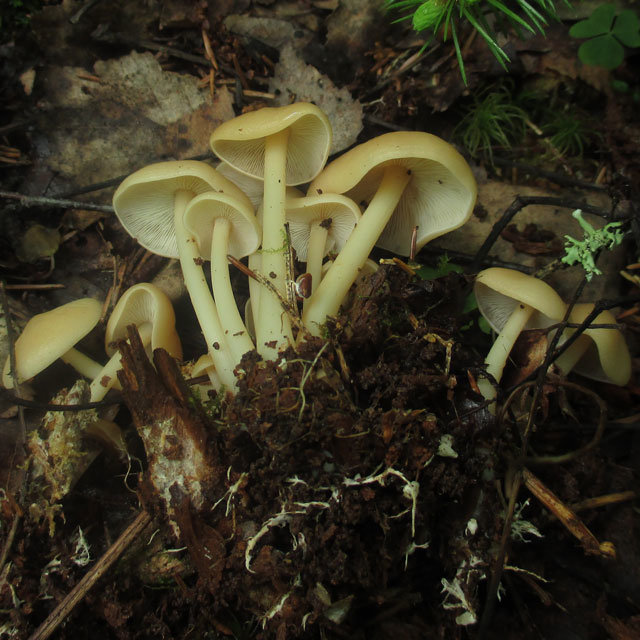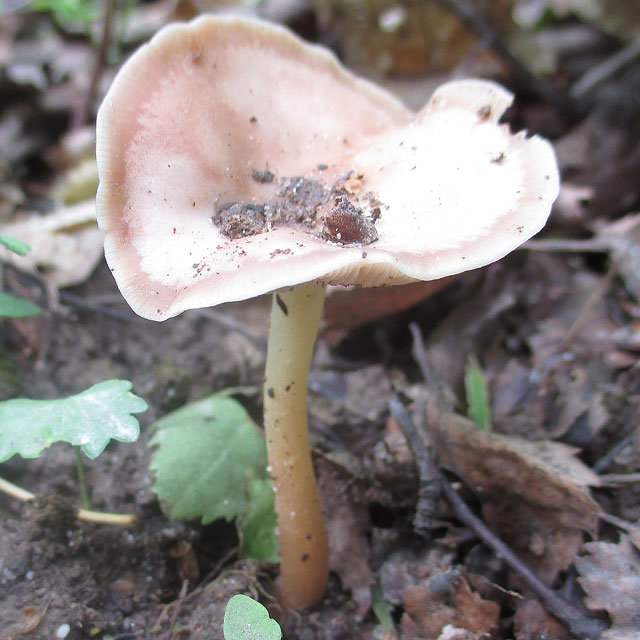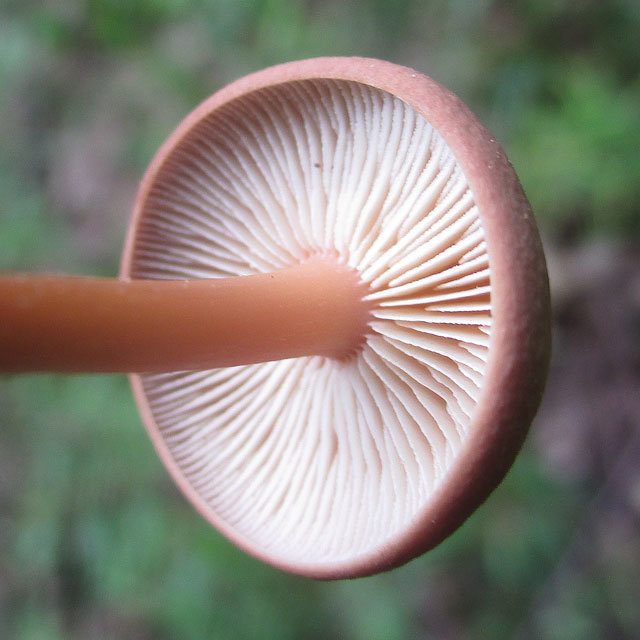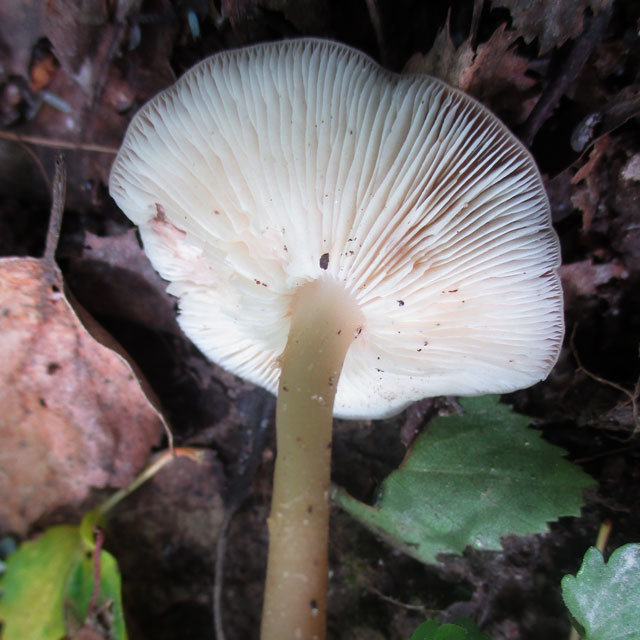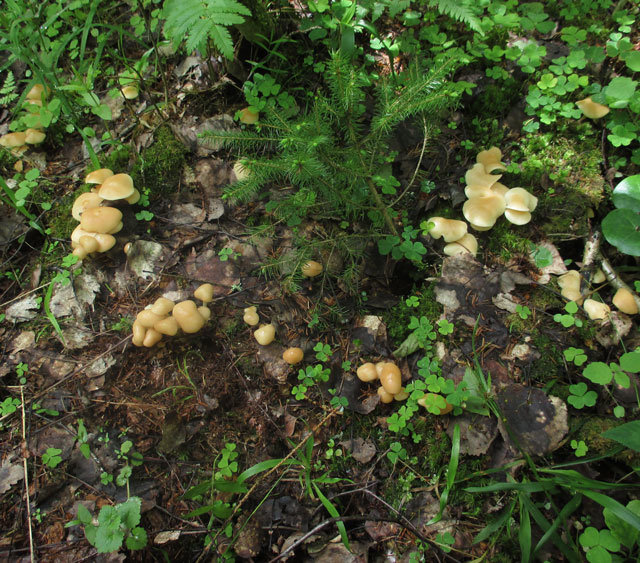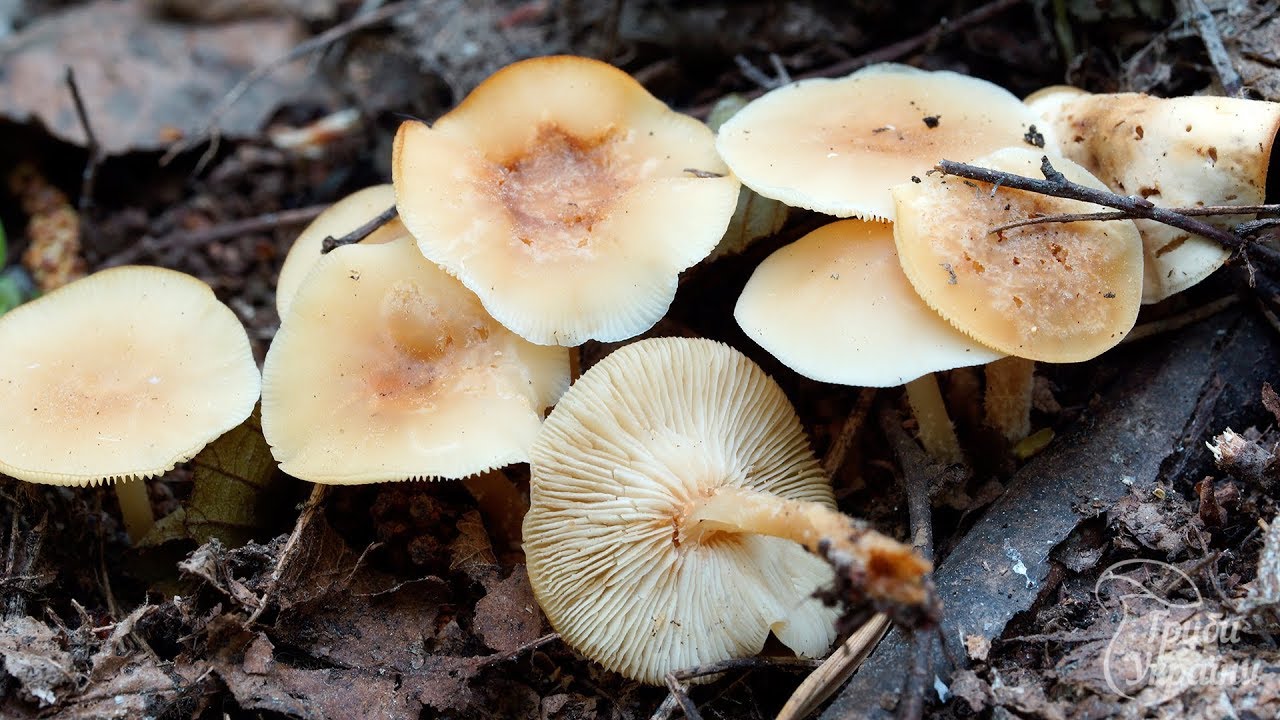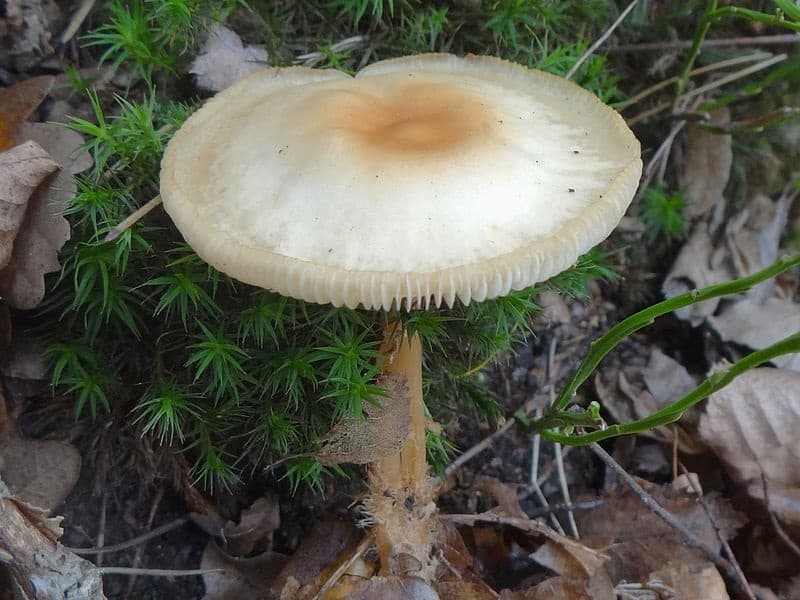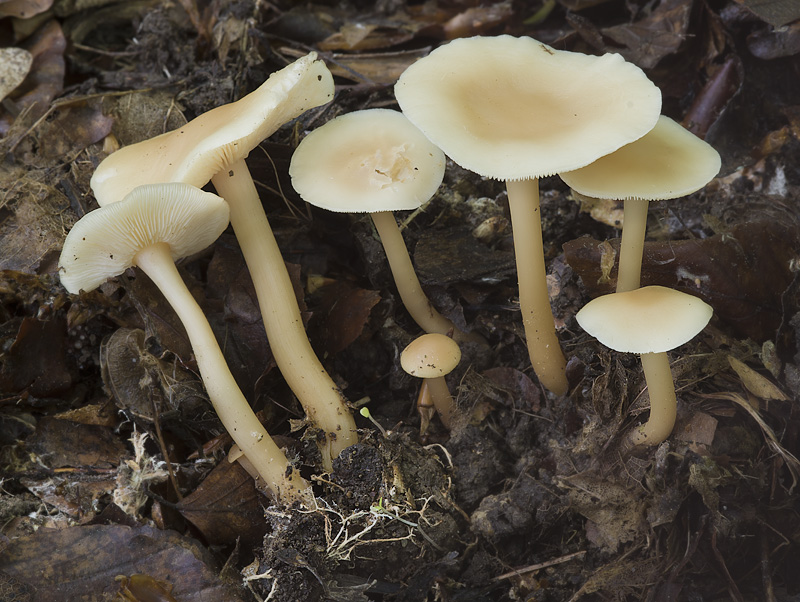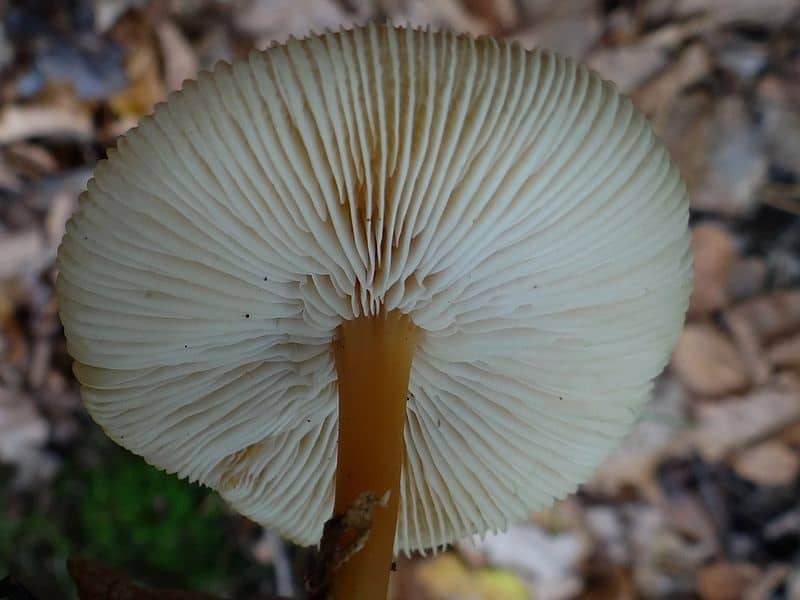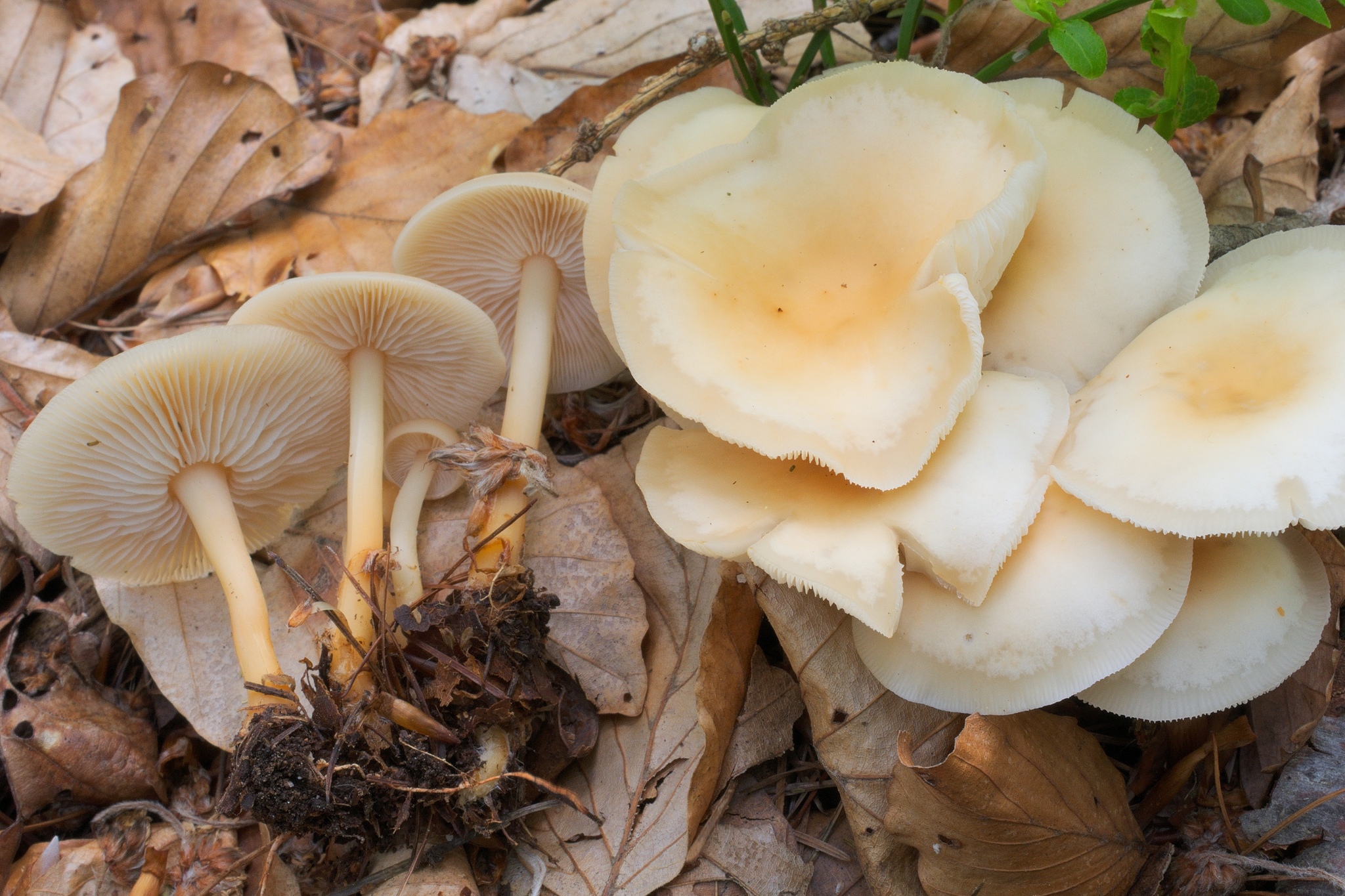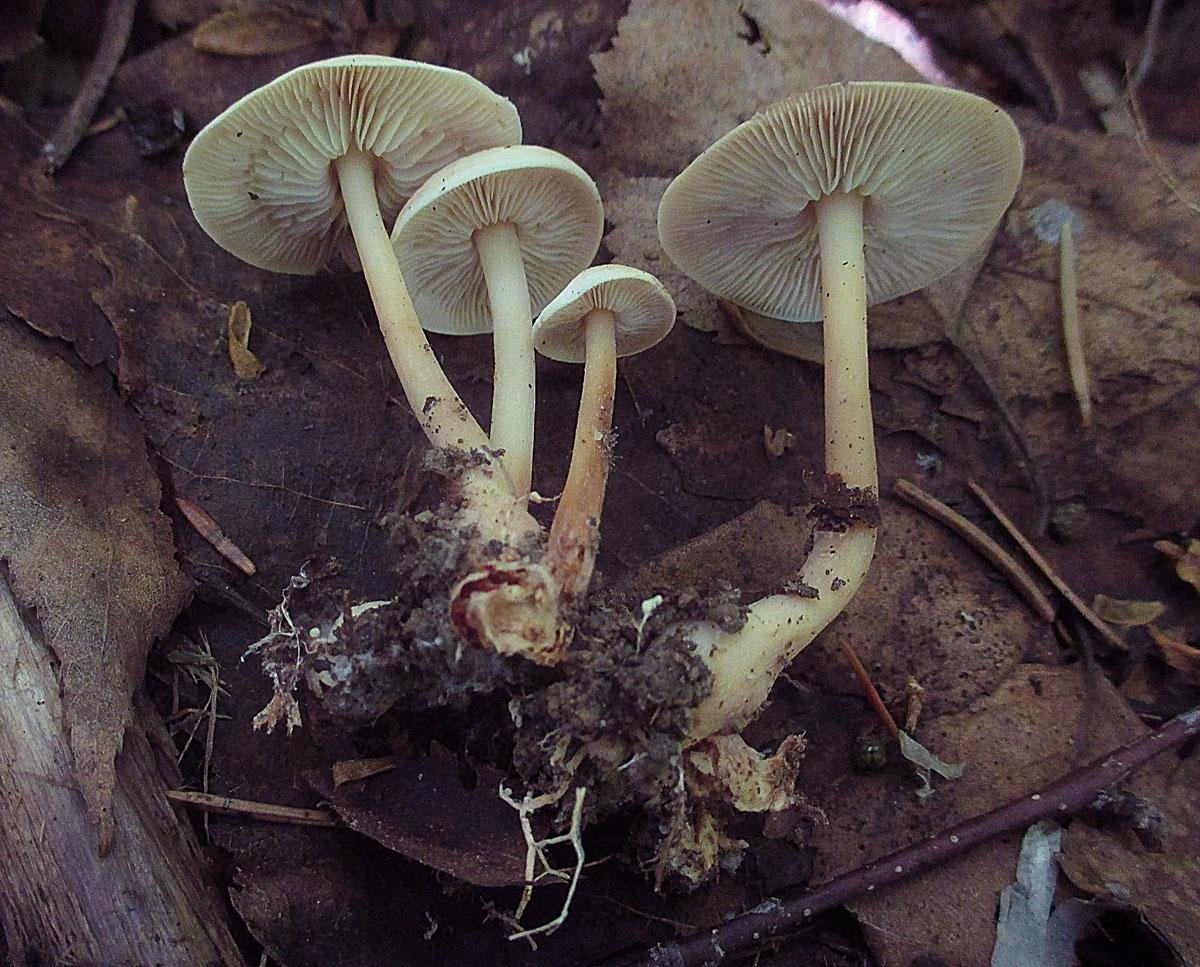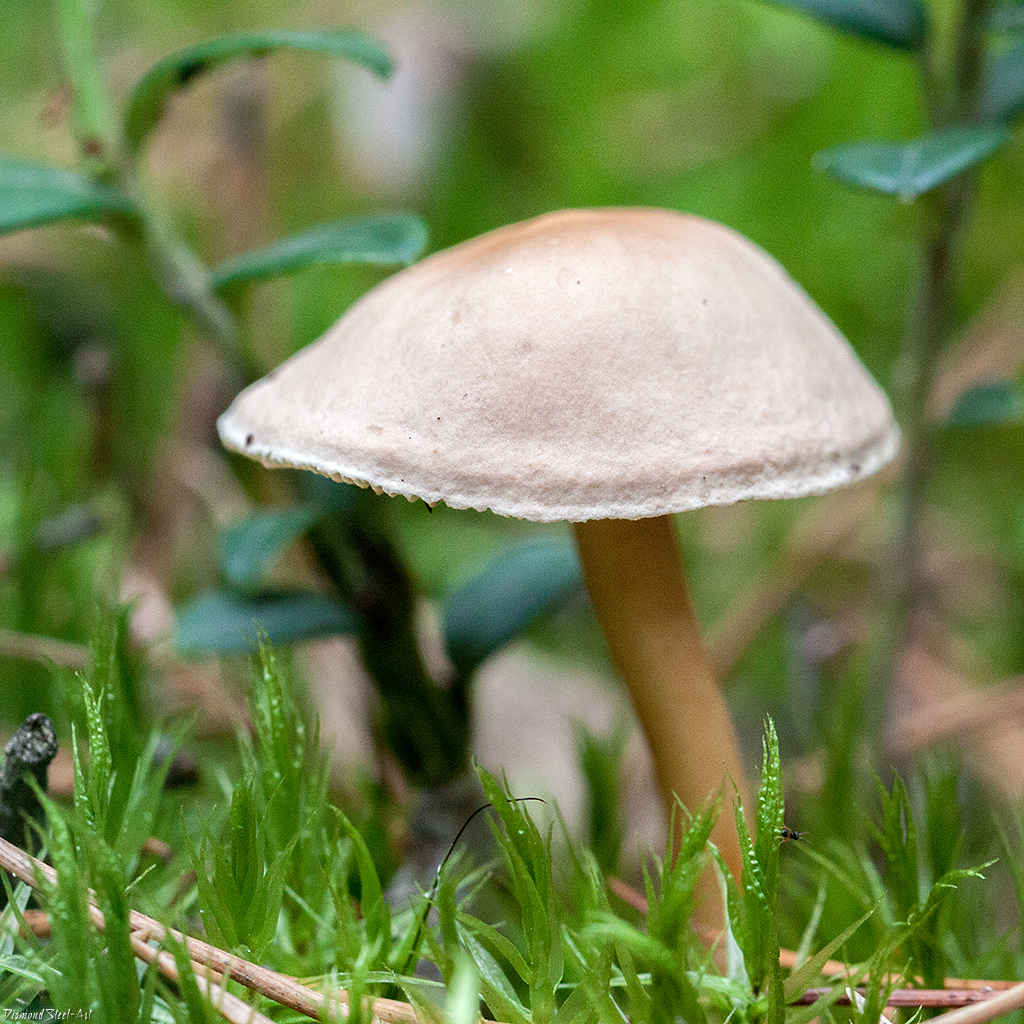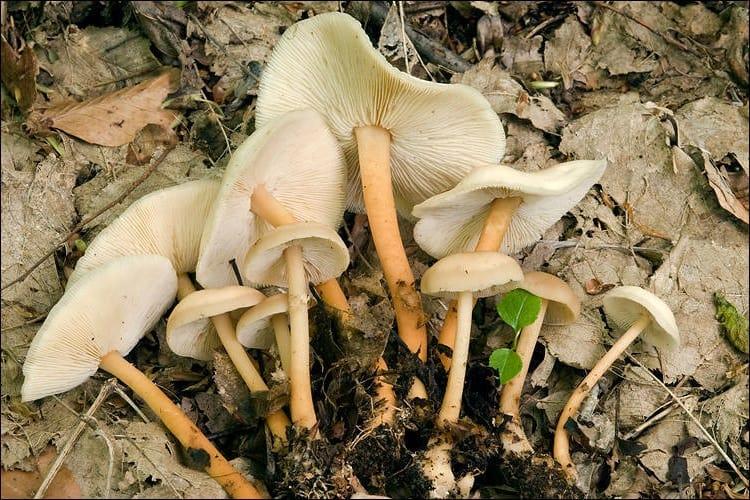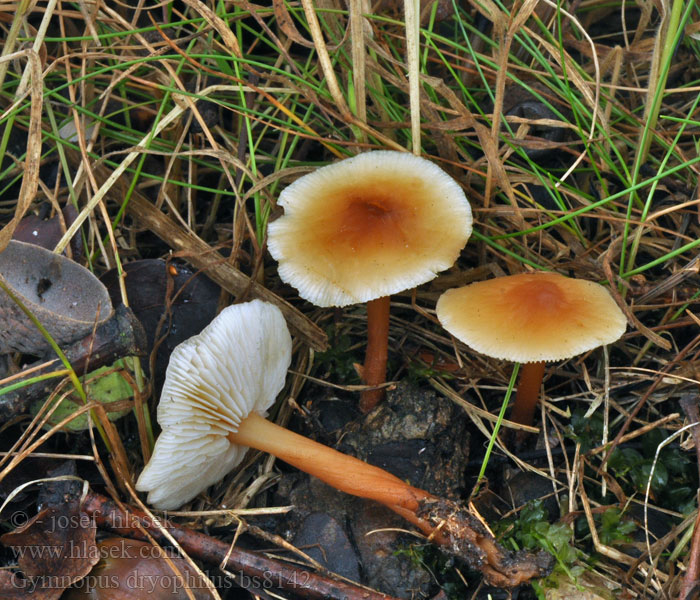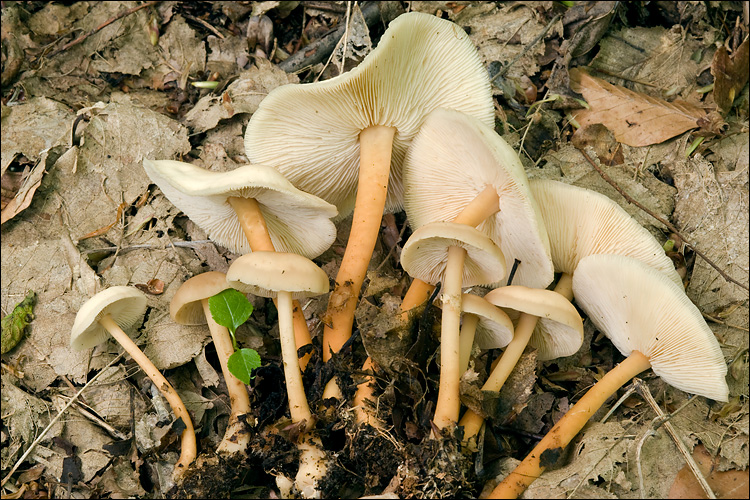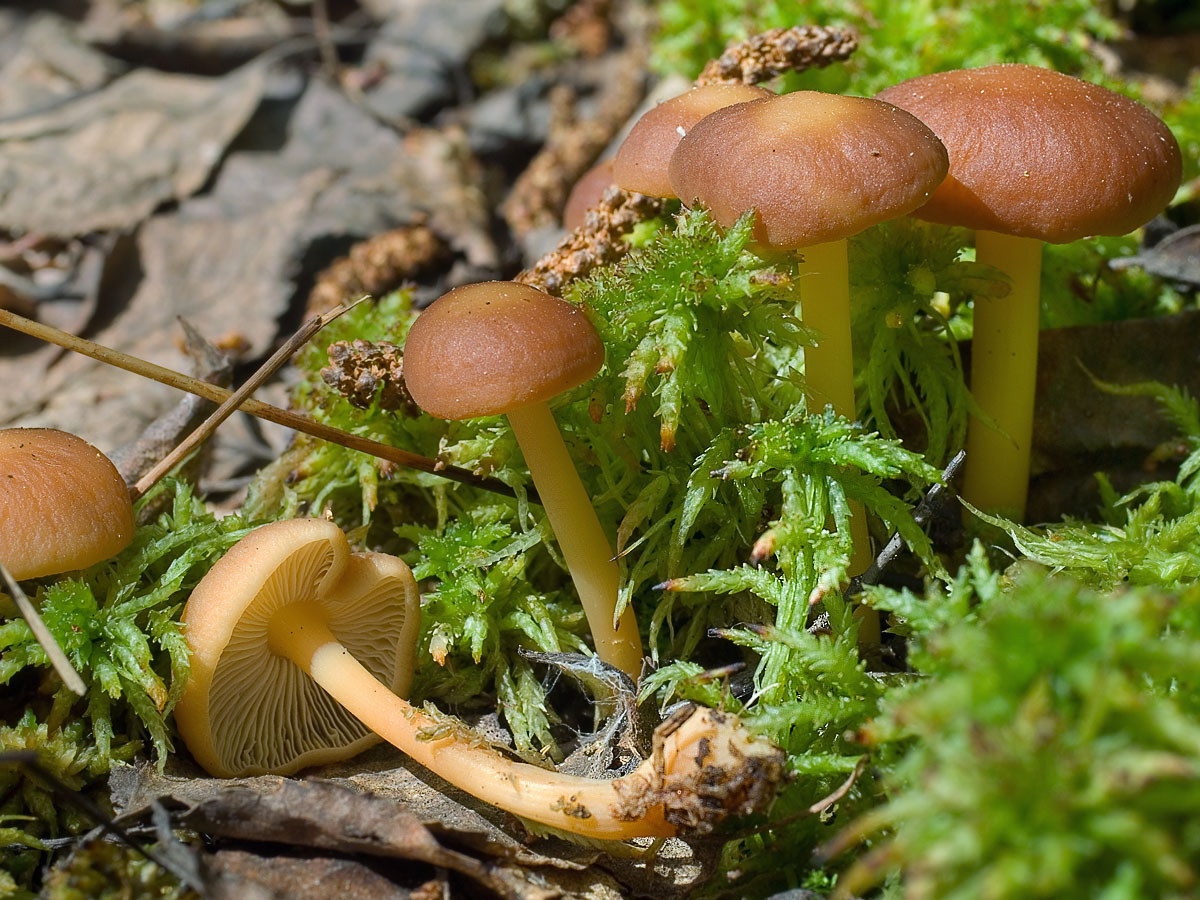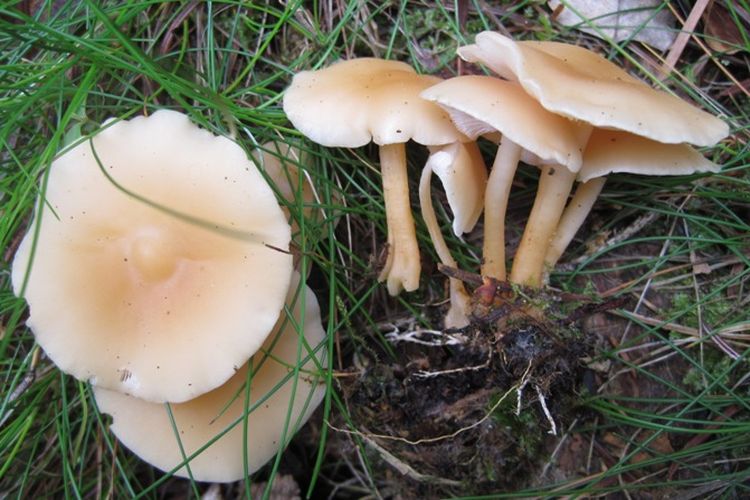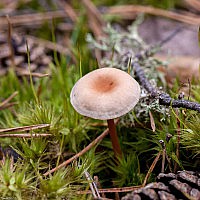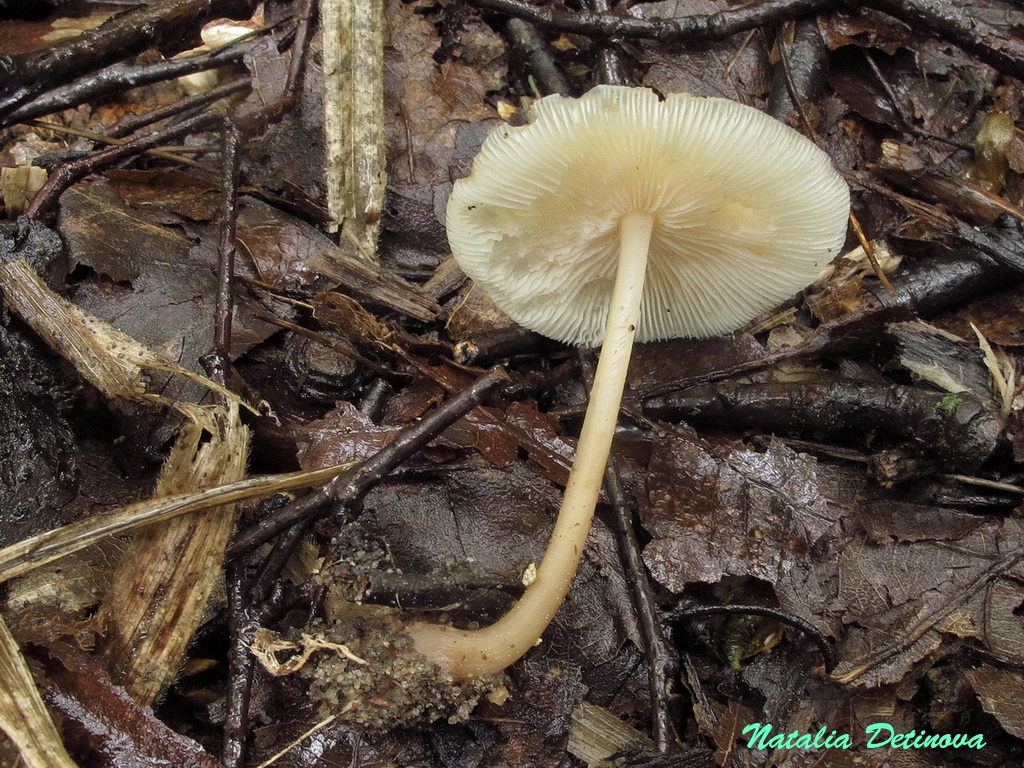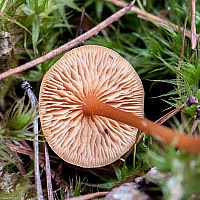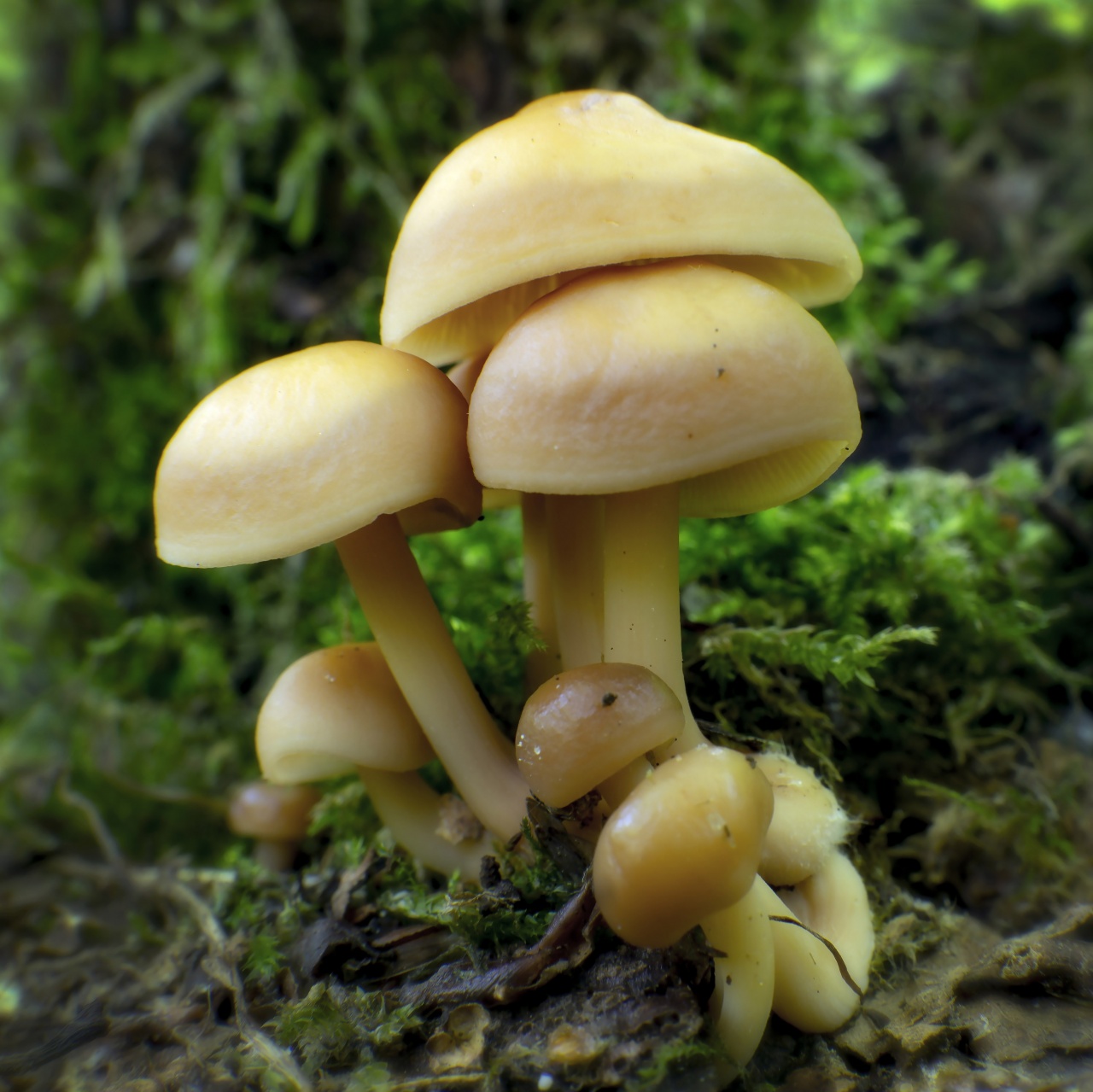Hymnopus water-loving
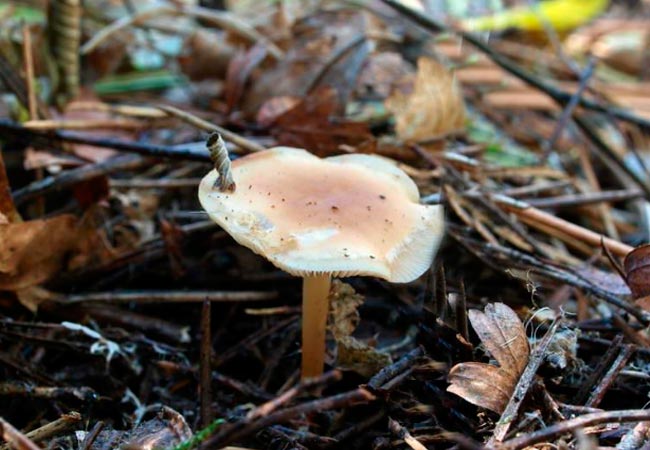
In mid-May, in forests rich in conifers, yellowish-buffy tiny mushrooms are born, taken by some mushroom pickers for mushrooms, others for toadstools. Nevertheless, the Water-loving Gymnopus does not belong to either edible mushrooms or poisonous mushrooms, but you can safely put it in your basket.
Hymnopus water-loving
Hymnopus water-loving - Gymnopus aquosus
In another way, such a hymnopus is called the Water-loving Colibia, Watery Hymnopus, Watery Colibia or Water-loving Negniychnik.
Description
Mushroom cap
In his youth, the Water-loving Negniyichnik builds up a convex hat, which eventually opens to a flat-outstretched state with downcast edges. The diameter of the "headgear" ranges from 20 to 60 mm. The hat edge in adolescence is even, later it often becomes wavy.
Hat surfaces are smooth and translucent. They are colored in a pale ocher, yellowish brown, pale brown, ocher, and sometimes orange-cream shade. In rainy weather, the hat absorbs moisture, becoming covered with wet spots or soaked in its entirety and acquiring a dark color.
Inside the caps there is a delicate whitish pulp, which is distinguished by its firmness and elasticity.
Hat bottoms of mature water-loving Colibia are speckled with frequent free plates. In adolescence, the plates grow to the legs in whole or in part. They are pale cream, white or yellowish in color. When spores ripen on them, the plates become richly creamy. Along with long plates, short ones are present in the hymenophore.
The water-loving hymnopus reproduces by elongated, smooth, droplet-shaped spores contained in a light creamy spore powder.
Stipe
The graceful leg of Colibia watery reaches 30-80 mm in length and 2-4 mm in thickness. It has the shape of a cylinder, expanding downward and forming a kind of bulb, on which white fluffy particles of mycelium with pinkish or ocher mushroom filaments are visible. The leg is painted to match the color of the hat surface, but it can also be pinkish.
Growing places
The water-loving iris prefers places with swampy soils or groundwater flowing close to the surface. It is found in conifers and mixed forests with conifers and broadleaf trees.
He takes a liking to any environment - soil with woody humus, wood residues, leaf and coniferous litter, bryozoans, grassy places, bark overgrown with moss.
Depending on the climate, the mushroom bears fruit from the second half of May to the end of November.
Edibility
The pulp of Colibia water-loving has a faint aroma and an almost indistinguishable taste, but some scientific works indicate a sweetish taste of the mushroom.
Gymnopuses of this type are suitable for eating in any form.
Similar types and differences from them
The water-loving hymnopus resembles the following edible and conditionally edible mushrooms:
Colibia wood-loving
They are so similar to each other that it is possible to find the differences between these species only with the help of a microscope.
Colibia yellow-lamellar
It is also difficult to distinguish it from Colibia watery, but there are still differences:
- It has no bulbous expansion at the base.
- Its mushroom filaments are colored not in pink or ocher color, but in an uneven white - ocher: white fragments often alternate with ocher ones.
- It grows in any forests with rotten wood, often found in lowlands and parks with a soil rich in organic matter, and places with sparse grass cover.
But, since all doubles are edible, it is not scary to confuse them with a water-loving counterpart.
What does colibia water-loving look like?
Colibia water-loving is the only representative of the species, in which it is difficult to determine the clear color of the fruit body. In the dry season, the shade is light beige with an ocher color in the middle. Can be solid cream. If the season is rainy or the place is constantly humid, the water-loving hymnopus has a light or dark brown color.
Description of the hat
Colibia water-loving is a small mushroom, the diameter of the cap of which rarely exceeds 5 cm.
- in young specimens, the shape of the cap is rounded, sloping; as the mushroom matures, it becomes more open (to prostrate);
- the edges are lowered, uneven, transparent, the plates are visually defined;
- the surface is slightly bumpy, hygrophane, transparent, not slippery, but not dry either;
- the color is never uniform, the central part may be darker or lighter than the extreme;
- plates of two types: short, reaching the middle; long, rarely protruding beyond the borders of the cap;
- the plates are beige or with a yellow tinge, are sparsely located, firmly attached to the fruiting body;
- spores are white or creamy;
- the pulp is fragile, slightly sweet, beige or white, odorless.
Leg description
The leg of the water-loving hymnopus reaches 4-8 cm in length and about 1.5 cm in width. The color is light above, darker at the bottom. The shade does not differ from the color of the cap.
The leg is hollow, formed in the form of a cylinder, narrow near the cap and expanding towards the base.
The structure of the stem is rigid, fibrous, lined.
Collibia yellow-lamellar (hymnopus yellow-lamellar, Gymnopusocior): what mushrooms look like, where and how they grow, are they edible or not
June mushrooms
Gymnopus ocior - Colibia yellow-lamellar
Chondrostereum purpureum - Chondrostereum purpureum
Clitocybe gibba - Funnel talker
Polyporus melanopus - Polyporus the black-footed
Cordyceps entomorrhiza - Cordyceps gray-ash
Mycena haematopus - Mycena haematopus
Trichophaea cf. abundans
Marasmius ramealis - Sprigel sprig
Paxillus involutus - Slender pig
Polyporus melanopus - Polyporus the black-footed
Sphaerobolus stellatus - Star spherobolus
Photogallery Mushrooms of April and May
All rights reserved Material is the property of the authors and this site
Pluteus leoninus - Plutey lion-yellow
Cyathus striatus - Striped goblet
Psathyrella candolleana - Psathyrella Candolle
Myxomycetes Um2 - Myxomycetes
Mycena pura - Mycena clean
Tubifera ferruginosa - Rusty tubifera
Trichophaea cf. abundans
Puccinia coronata - Puccinia crown
Bolbitius reticulatus - Bolbitius reticulated
Hypocrea sulphurea - Sulfur-yellow hypocrea
Anthracobia cf. maurilabra - Dark-bordered Anthracobia
The photographs presented in this gallery were taken with a digital camera Canon PowerShot A630
Collybia dryophila - Collybia the lesbian
Cordyceps entomorrhiza - Cordyceps gray-ash
Lactarius tabidus - Stunted Miller
Polyporus badius - Chestnut Polyporus
Cordyceps entomorrhiza - Cordyceps gray-ash
Scutellinia sp. - Scutellinia
Artomyces pyxidatus - Artomyces piriformis
Leccinum scabrum - Common boletus
Hapalopilus rutilans - Hapalopilus reddish
Ceratiomyxa porioides - Ceratiomixa poria
Continuation of the photo gallery Mushrooms of June
Gymnopus yellow-lamellar (colibia yellow-lamellar): photo and description
| Name: | Gymnopus yellow-lamellar |
| Latin name: | Gymnopus ocior |
| Type of: | Edible |
| Synonyms: | Collybia yellow-lamellar, Hymnopus early ripening, Collybia ocior, Collybia funicularis, Collybia succinea, Collybia extuberans, Collybia xanthopus, Collybia xanthopoda, Collybia luteifolia, Collybia aquosa var ocior, Collybia dryophila var xanthopophila, vararami dryus extinct Marasmius dryophilus var funicularis, Chamaeceras funicularis, Rhodocollybia extuberans |
| Specifications: |
|
| Systematics: |
|
Colibia yellow-lamellar is an edible variety of the mushroom kingdom. But very often mushroom pickers ignore this species, implying a poisonous variety by it. During mushroom hunting, in order not to accidentally collect false doubles, it is necessary to study the characteristic features of the variety and view the photo.
Varieties
Spindle-footed
Collibia fusiform grows on the stumps and roots of old deciduous trees, preferring oak and beech. A hat with a diameter of 4.0-8.0 cm, with a blunt tubercle. The pulp is tough. The spindle-shaped leg is 4-8 cm long, 0.5-1.5 cm thick. The color range is in red-brown shades.
Widely distributed in European forests. The fruiting period is in summer and autumn. It is considered inedible, but there are cases of the use of young specimens with exquisite gastronomic qualities. Overgrown specimens cause mild poisoning.
Oil
Colibia oil prefers coniferous forests, grows in colonies. The fruiting period is July-November.
A hat with a diameter of 2-12 cm, the surface is smooth, when moisture gets in, it becomes oily, which became the determining factor in the name of the species.
Irina Selyutina (Biologist):
The flesh of the cap of the oil colibia has an interesting feature - hygrophane, i.e. it is capable of swelling when exposed to moisture. This is due to the fact that the trama (false tissue) of such pulp is represented by a loose weave of hyphae. And it is in these gaps between them that the water coming from the environment is retained. Gigrofanny hats are capable of changing color depending on the weather. So, when dry, concentric zones appear on their surface, and their distribution can go from the center to the edge or vice versa.
The color is brown or with shades of red. Mushroom stem 2-10 cm long, 0.4-1.0 cm thick, often hollow, hard, smooth surface. It belongs to the edible species.
Lazy
The fungus grows in colonies
Wood-loving colliery grows in small colonies in mixed woodlands along with oak and pine, preferring decaying wood and fallen leaves. The fruiting period is June-November.
The hat is 1-7 cm in diameter, the color is initially red-brown, later with an orange tint or yellow-brown. The flesh of the cap is thin, whitish, characterized by the presence of hygrophilousness. The mushroom leg is 3-9 cm long and 0.2-0.8 cm thick. Collebia wood-loving belongs to the edible species.
Bored
Crowded collibia is found near grassy paths, in clearings in coniferous forests, in hilly areas.
The cap is 1-4 cm in diameter, convex in young specimens, and straightened in adults. The surface is glossy. The hymenophore is pinkish. The leg is in the form of a cylinder, 5-10 cm high, up to 3 mm thick. The fruiting period is in spring-autumn.
The mushroom is an edible variety, but it does not have much culinary value due to its small size.
Wide-lamellar
Colibia broadly lamellar is one of the early lamellar fungi. Grows singly or in small colonies. It is a saprotroph, preferring the rotten stumps of broad-leaved trees.
A hat with a diameter of 5-12 cm, radially cracking in dry weather. A tubercle remains in the center of the cap. In adult mushrooms, the edges may bend upward. The surface is gray or brown. Mushroom stem 4-15 cm, cylindrical, widened at the base, dense in structure.
It belongs to the edible species.
Water-loving
Colibia water-loving, or hymnopus water-loving, grows in forests in wetlands with stagnant water, near the passage to the surface of groundwater, prefers moss, grass and soil rich in woody debris. The fruiting period is mid-May-November.
Mushroom cap with a diameter of up to 6 cm, initially with even, later with wavy edges. The surface is smooth. The color is usually cream, light brown. The leg is up to 8 cm long, 0.2-0.4 cm thick, in the form of a cylinder.
It belongs to the edible variety.
The money is merging
In some forests, there are whole clusters of long-legged bell-shaped mushrooms, gathering in rosettes of 2-9 or more specimens. With this quality, they resemble honey mushrooms, stuck around the stumps with numerous families. However, confluent money, unlike edible mushrooms, is not recommended for culinary purposes.
The money is merging
Money confluent - Latin Gymnopus confluens
In another way, this pretty-looking fungus is called Colibia fused, Colibia fused, Colibia fused, Money fused, Colibia fused or Money fused.
Description
Mushroom cap
The caps of the young Colibia merging reach 20 mm in diameter, and have a convex hemisphere shape. As they grow, the diameter of the hats varies from 40 to 60 mm, and they themselves turn into wide cones or bells, similar to Vietnamese hats with mild mounds in the middle. Occasionally, depressions appear on the caps, often thin wavy edges.
The hat surface is covered with a smooth glossy skin, through which a lamellar bottom is visible at the edges. It is colored light ocher, brown ocher or dark red and has light edges. Over time, the caps fade to a fawn or cream shade.
From the inside, they are filled with watery, but tight flesh of a fawn tone. Under the hat there are many narrow accrete plates with small teeth along the edges. With age, the plates of Colibia growing together are separated from the leg. They are whitish or yellowish in color.
Fused money reproduces by whitish elongated spores contained in white spore powder.
Stipe
The length of the legs of the confluent money reaches 40-100 mm, the thickness is 2-5 mm. Longitudinally folded legs are cylindrical and do not fill with pulp.
The legs themselves are pretty stiff. At first, they turn whitish or yellow - ocher color, darkening downward. Adult mushrooms have rusty-red or reddish-brown legs, covered with the smallest whitish bloom. Their bases are much more pubescent.
Growing places
Collibia growing together prefers floodplain deciduous forests with alder, birch and poplar, it is found on stony areas, fallen leaves and litters.
Fruiting is often in a group: mushrooms, growing together by roots, form numerous rosettes. They bear fruit from July or August to November.
Although the flesh of these collibii has a mild taste, it smells so disgusting of rotten cabbage that it is not eaten, especially since the legs are very stiff.
Collibia crowded (Gymnopus acervatus) what mushrooms look like, where and how they grow, are they edible or not
Collibia crowded: photo and description
| Name: | Collibia crowded |
| Latin name: | Gymnopus acervatus |
| View: | Conditionally edible |
Collibia crowded - conditionally edible forest dweller. It grows on stumps and decayed coniferous wood. Caps of young mushrooms are used for food, since the flesh of old specimens is tough and fibrous
Because this species has inedible counterparts, it is important to get acquainted with the external description, analyze its photos and videos
How does Collibia look crowded?
Colibia crowded is prescribed for edibility group 4. In order not to be deceived during mushroom hunting and not to collect toxic specimens, you first need to get acquainted with the external parameters.
Description of the hat
The cap is small, up to 4 cm in diameter. In young mushrooms, the shape is convex, straightens with age, leaving a small mound in the very center. The surface on a matte base is smooth, covered with a dark brown paint. In dry weather, the skin becomes wrinkled, brightens and takes on a fawn color. The pulp is dense, watery, without a pronounced taste and smell.
The spore layer is formed by thin, innumerable plates, which are connected to the pedicle at a young age, and then become free. The plates are colored light lemon. This species reproduces by whitish, ovoid spores that are embedded in a white spore powder.
Eat a mushroom or not
This representative belongs to conditionally edible species. Only the upper part of young specimens is suitable for cooking.Before cooking, the harvested crop is sorted out, washed and boiled for 10-15 minutes. Then the mushrooms can be stewed, fried and preserved.
Where and how it grows
Large mushroom families prefer to grow on stumps and decaying coniferous wood. They can be seen along paths, in parks and squares, on the hillsides. Begins fruiting from July to October.
Doubles and their differences
This species, like all the inhabitants of the forest, has edible and inedible counterparts. These include:
- Red-footed is an edible species with a reddish-brown cap and a thin, long stem that is painted in the color of the cap. It prefers to grow on stumps among deciduous trees. It bears fruit during the entire warm period.
- Spindle-footed is an inedible species that loves to grow on stumps and rotting wood. You can recognize it by its smaller size and fusiform stem. Begins fruiting in the period from July to September.
- Oil - belongs to the 4th group of edibility, grows from July to October among spruce and deciduous trees. Small representatives have a dense, glossy surface. In the rain, it becomes shiny and covered with mucus. The pulp without a pronounced taste and smell. Only young specimens are used in cooking.
Conclusion
The crowded colliery is a conditionally edible specimen of the Negniychnikov family. It grows on stumps and felled wood, bears fruit throughout the warm period. In cooking, only the part on top is used, which is washed and boiled in advance. Since the mushroom is very similar to toadstools, only an experienced mushroom picker should carry out their collection.
Bristle-footed beetle (Marasmius androsaceus)
- Other names for the mushroom:
- Stamen grass
- Stamens
Other names:
- Garlic bristle-legged;
- Stamen-shaped garlic;
- Gymnopus_androsaceus
- Setulipes androsaceus.
Bristle-legged non-fungus (Marasmius androsaceus) is a fungus of the Tricholomov family (Ryadovkovy).
External description
The bristle-stem (Marasmius androsaceus) is a fruiting body, consisting of a cap, initially convex, gradually becoming widespread, as well as a thin stem, characterized by hardness, fragility and a shiny surface. The surface of the leg is covered from above with horn-like scales, and it itself has a height of 3 to 6 cm, and a diameter of no more than 0.1 cm.
The diameter of the cap is 0.4-1 cm, the disc of its surface is depressed, and the cap itself in young mushrooms has a whitish color, folds and stripes. Subsequently, in ripe fruit bodies, the cap becomes gray-brown, or gray-cream. In the central part, the color of the cap is slightly darker. Radially located strokes and grooves are noticeable along its edges. The hymenophore is represented by plates, located rarely and adhered to the surface of the leg. The plates are very narrow, the color is the same as the cap. The described type of mushroom has one feature. The plates do not form a ring around the base of the leg, as is the case with any other types of non-nippers, but descend to the surface of the leg, descend along it.
The spore powder in bristle-legged non-nippers is characterized by a white color, and the pulp of these mushrooms has a characteristic unpleasant odor.
Season and habitat
The bristle-stem (Marasmius androsaceus) bears fruit from June to September. The main habitats of the fungus are small twigs that have fallen from trees. Also, this type of mushroom can be found on old coniferous wood, on fallen needles and dried leaves. Often, the non-stony bristle-leg can be seen in the middle of the sand dunes, in the wastelands. It forms large colonies, which include several dozen small fungi. This type of fungi forms rather dense, horsehair-thick weaves of hyphae, which subsequently colonize the unoccupied substrate, making it suitable for other plant organisms.Especially abundant nonnium bristle-legged bears fruit in the period when heavy and warm rains have just passed. It forms huge colonies in areas completely covered with fallen old needles.
Edibility
Reliably nothing is known about the toxicity of the nonnium bristle-legged. It is possible that this mushroom does not contain a large amount of toxic substances. However, it is not eaten, and the reason for this is the unpleasant smell of pulp.
Similar types and differences from them
The bristle-stem fungus has a slight resemblance to the Micromphale perforans fungus, however, the stem of this fungus has a felt structure, and the flesh is characterized by a sharp aroma of rotten cabbage.
Hymnopus early maturing (Gymnopus ocior)
Current title
| Index Fungorum | Gymnopus ocior (Pers.) Antonín & Noordel. | |
| MycoBank | Gymnopus ocior (Persoon) Antonín & Noordeloos |
Systematic position
Etymology of the species epithet
Ōcior, ōris сompar .; no posit. 1) faster, faster; rather acting; 2) earlier, early maturing.
Synonyms
- Agaricus ocior Pers., Mycol. eur. (Erlanga) 3: 151 (1828)
- Collybia ocior (Pers.) Vilgalys & O.K. Mill., Trans. Br. mycol. Soc. 88 (4): 467 (1987)
- Collybia xanthopus (Fr.) Sacc., Syll. fung. (Abellini) 5: 226 (1887)
- Collybia funicularis (Fr.) Métrod, Revue Mycol., Paris 17: 90 (1952)
- Collybia succinea Quél., Mém. Soc. Émul. Montbéliard, Sér. 2 5: 237 (1872)
- Collybia extuberans (Fr.) Quél., Mém. Soc. Émul. Montbéliard, Sér. 2 5: 237 (1872)
- Rhodocollybia extuberans (Fr.) Lennox, Mycotaxon 9 (1): 222 (1979)
- Collybia luteifolia Gillet, Hyménomycètes (Alençon): 328 (1876)
Other names: Collibia yellow-lamellar.
Habit
Fruit body: Cap and stem (agaricoid)
Hymenophore: Lamellar (including folded or with rudimentary plates)
Hat
The cap is 10 - 40 mm in diameter, initially convex, then prostrate with a tubercle in the center and an uneven edge, hygrophane, dark red or orange-brown, with a narrow yellow, yellow-red annular zone along the edge. The surface is smooth, slippery in wet weather.
The plates are adherent or adherent with a tooth, yellow, cream or white.
Smell and taste are weak, mushroom.
Leg
Stem 20 - 60 mm long, 2 - 5 mm in diameter, cylindrical, sometimes widening towards the base, hollow, smooth, yellow, ocher, reddish brown, darker downward.
Microscopy
Spore powder from white to cream color.
Spores (4.6) 5.1 - 6.3 × 2.5 - 3.5 (4.0) μm, Q = 2.0, broadly ellipsoid or ovoid.
Basidia 18 - 22 × 5.0 - 8.0 μm, clavate, 4-spore, with a buckle at the base.
Basidiols 11 - 21 × 3.0 - 9.0 μm, clavate, cylindrical or fusiform.
The edge of the plate is sterile.
Cheilocystids 12 - 45 × 3.0 - 9.0 µm, irregular, clavate, with outgrowths or with a spherical end, less often coral-shaped, thin-walled, sometimes inlaid.
Pleurocystids are absent.
Trama laminae consists of branched cylindrical hyphae up to 9.0 µm in diameter.
Pileipellis consists of hyphae 7.0 - 19 µm in diameter, with lobed terminal elements.
Buckles are common.
Ecology and distribution
- Substance: Woody plants (living trees, bark and dead wood)
- Substrate: Soil, litter
It grows, as a rule, in groups on the soil, among grasses, mosses or on decaying wood in deciduous, coniferous and mixed forests. In Novosibirsk Akademgorodok, it is common throughout the warm season in forest plantations and park areas, preferring shaded areas rich in organic matter, including those from dog walking, areas with sparse grassy cover.
Fruiting
The divisions correspond to the decades of the month.
Nutritional properties
Similar species
- Alpine hymnopus (Gymnopus alpinus) - differs mainly in the form of cheilocystids and in the large size of the spores.
- Gymnopus oak-loving (Gymnopus dryophilus) - lighter in color.
Related materials
- Antonin V., Noordeloos N. E. A monograph of marasmioid and collybioid fungi in Europe. - Eching: IHW-VERLAG, 2010 .-- 480 p. - P. 179.
- Knudsen H., Vesterholt J., eds. Funga Nordica. - Copenhagen: Nordsvamp, 2012 .-- P. 345.
Link to this page for prints
Ageev D.V., Bulonkova T.M. Early ripening hymnopus (Gymnopus ocior) - Mushrooms of Siberia URL: https://mycology.su/gymnopus-ocior.html (date of access: 28.02.
Share link
Discussions
| Identifier: | 11424 |
| Responsible: | Dmitry Ageev |
| Date of creation: | 2016-01-21T01: 31: 23 |
| Last modified date: | 2018-11-15T05: 41: 50 (Dmitry Ageev) |
OOO OOO OOO OOO OOO OOO OOO OOO OOO OOO OOO OOO OOO OOO OOO OOO OOO OOO OOO OOO OOO OOO OOO OOO OOO OOO OOO OOO OOO OOO OOO OOO OOO OOO OOO OOO OOO OOO OOO OOO OOO OOO OOO OOO OOO OOO OOO OOO OOO OOO OOO OOO OOO OOO OOO OOO OOO OOO OOO OOO OOO OOO OOO OOO OOO OOO OOO OOO OOO OOO OOO OOO OOO OOO OOO OOO OOO OOO OOO OOO OOO OOO OOO OOO OOO OOO OOO OOO OOO OOO OOO OOO OOO OOO OOO OOO OOO OOO OOO OOO OOO OOO OOO OOO OOO OOO OOO OOO OOO OOO OOO OOO OOO OOO OOO OOO OOO OOO OOOì
Age restrictions
Federal Law of the Russian Federation of December 29, 2010 No. 436-FZ "On the Protection of Children from Information Harmful to Their Health and Development."



